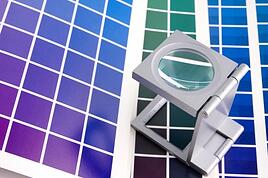Just in case you’re unfamiliar with the major differences between digital printing and offset (or lithographic) printing, this blog post is for you.
Marketers care about getting a job printed well, on time, as expected, and within a budget. Commercial printing companies know this too well. It’s not necessarily up the customer to determine which printing process works best for a particular job. Get your printer involved, and the sooner the better.

There are a few guidelines about digital vs. offset to tuck away in your “Getting Things Printed” folder (you do have one, right?). This will come in handy for your whole marketing and design team.
Digital Printing
Best suited to smaller quantities. If you’re printing a few, a few dozen, or a few hundred copies of something, chances are good you’ll go digital.
Faster turnaround. You’ll get your digitally printed jobs done faster. There’s a lot less time getting files ready to print (a traditional step called “make ready,” which is all but eliminated on digital jobs). Many digital jobs can be printed and delivered in a matter of days.
You can personalize with digital. This may be the #1 difference and benefit of digital printing. Because every image is unique, it can be personalized. Text and graphics can be customized on your printed pieces, using a database that’s merged with the design template. Variable data printing is, as marketers know, effective for advertising and business development.
It’s cheaper to print low volumes. With digital, you have set costs – every image costs the same. There’s no make ready, so it’s less expensive to get the job done.
Limited paper options. Although it’s getter better over time, digital printing paper options are nowhere near as flexible as offset printing.
Limited size options, too. Size does matter when it comes to printing digitally. You can do so much more with offset printing, and the same goes for finishing options.
Image quality. Print purists still feel that offset quality surpasses digital quality, although new technologies are chipping away at this prejudice and it takes a very experienced eye to spot the difference.
Offset Printing
Higher print quality. Particularly with images and spot (Pantone®) colors, offset is better suited than digital and delivers better print quality.
Wider range of paper and other substrates. You can print on any kind of paper and unusual substrates, like plastic and leather, using offset lithography. There are thousands of paper choices, and that’s not true for digital.
Variety of formats. With offset, you have more freedom to design your print materials as you wish. There’s a broad range of finished sizes and shapes. You’re really only limited by your designer’s imagination.
More cost effective for long runs. It’s a funny thing, but as your print volume increases, your unit price decreases with offset printing. With digital, you pay the same per-image price no matter how many you print.
Takes longer to print and deliver. Offset printing is a traditional manufacturing process. There’s prepress, getting the presses ready to print, printing the job, and then the post-press (binding, finishing, etc.) stages. You can’t expect an offset job to be done overnight.
So if you’re not sure which way to go – offset or digital – keep these differences in mind, and most importantly have a conversation with your commercial printer.
Image courtesy of posterize / FreeDigitalPhotos.net

